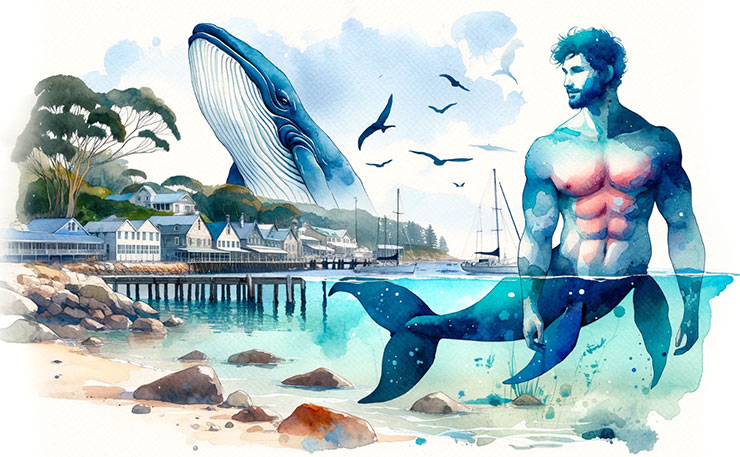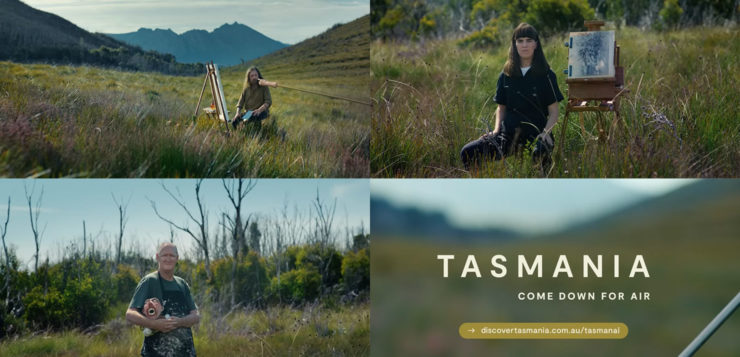An ingenious tourism campaign out of Tasmania may (or may not) increase visitor numbers, but it’s sure to boost the morale of local artists, writes Emma Wilkins.
An advertising campaign that claims AI is no match for authenticity, and seeks to show the world that “instant isn’t always better”, has sprung from an unlikely source.
Earlier this month, a competition on a government-run tourism website in Tasmania invited members of the public to submit creative prompts for artworks “set” in the state. Now, those selected by participating artists are being turned into physical, human-made art. When each piece is complete, the person who penned the prompt will receive the resulting art.
A promotional clip depicts a lone artist in a sweeping landscape turning down suggestions such as “An enormous baby on Cradle Mountain”, before accepting “A sexy merman but he’s half whale in Bicheno” with the disclaimer: “It might take me a little while though”.
“TasmanAi.” It’s an idea I’d have expected to attract excitement in a brainstorming meeting — before being shot down as being a little too quirky, a little too impractical, a little too much, well, work.
Instead, Tourism Tasmania ran with it, putting an “image generator” on its website so “Tasmanian artists — not algorithms” could produce human-made art in “the most inspiring place on Earth”. (I’d have settled for “an” inspiring place, but I guess it wouldn’t be advertising without at least one utterly audacious claim.)
If Tourism Tasmania’s goal is to support and inspire local artists whose livelihood is being threatened by technology – to promote their work and encourage community engagement – I expect this initiative will meet some KPIs. But even if the entry form ensured each prompt was “paired with an iconic place in Tasmania”, even if each artwork depicts and is created in the state, will the campaign really make people associate Tasmania in particular with “authenticity and creativity” and the joy of “slowing down”?
Time will tell. Either way, I love the initiative. It celebrates individual artists and will foster the creation of original work, work that’s been “prompted” by a particular place and a particular human, a human who will — in good time and in “real life” — receive it.
I also love the execution. The quirky, offbeat promotional clip is a delight to watch, and the website was clean, easy to use, and playful (“Why let robots have all the fun?”). The prompts offered the artists inspiration, while the ability to reject the ideas that don’t appeal and accept the ones that do gives them agency.
Even if people don’t go from entering the competition to visiting Tasmania, I trust my taxpayer dollars have been well spent. Regardless of whether this idiosyncratic marketing campaign raises the profile of my home state, it will surely raise the profiles of the artists involved and, hopefully, boost morale among creatives more generally.
Some have responded to the threat of AI with breathless excitement or scaremongering, others with intellectual arguments. This response uses technology to centre and facilitate human creativity and particularity. It contributes to the conversation with refreshing, laid-back confidence.
I know the competition is aimed at “potential visitors” to the state, but I couldn’t resist entering. It took a minute to find the website (when I googled “Tasmanai” the robots “corrected” my spelling), and to think of a worthy prompt. After submitting my idea, I was told it had been put into a “high tech image generator”—“AKA Trevor, Kate, and Sandy having a bickie and tea in the studio”.

“They’re going to mull over your creative genius and we’ll get back to you. Why not explore Tasmania while you wait?”
There’s a place for the efficiency and immediacy of machine-generated art, but there’s something even more exciting about art that takes effort and time, that was inspired and made, by and for, people bound by time and place.
However aesthetically impressive it might become, I can’t imagine the former will ever be imbibed with as much meaning as the latter. Whatever this competition’s “prizes” look like, and however much the winners appreciate them (or don’t…) each will have its own unique “creation story” and its own unique creator.
A creator who, unlike a machine, has a family and friends and commitments and desires that limit (and inspire) them. A creator who might take a while to decide how they’ll respond to a prompt, and a while to start, and a while to finish. Setting up an easel and getting out the paint is harder than watching another episode of another show while eating another biscuit — but they’ve made a commitment. And the end result will — they hope; they can’t be sure — bring delight to the one whose prompt inspired it.
We can’t beat the robots when it comes to speed, but with playful, good-natured humour, and slow, inefficient labour, we can distinguish ourselves from them. Our ways are not their ways. This can be a curse. But it can be a blessing too.
Donate To New Matilda
New Matilda is a small, independent media outlet. We survive through reader contributions, and never losing a lawsuit. If you got something from this article, giving something back helps us to continue speaking truth to power. Every little bit counts.




